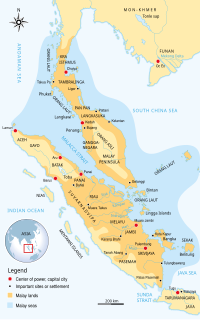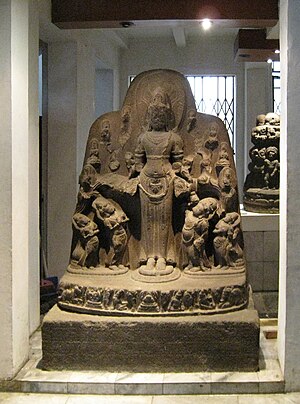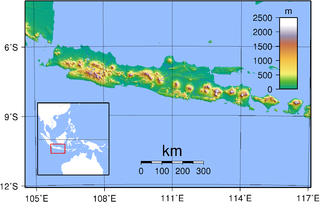
Srivijaya, was a dominant thalassocratic Indonesian city-state based on the island of Sumatra, Indonesia, which influenced much of Southeast Asia. Srivijaya was an important centre for the expansion of Buddhism from the 8th to the 12th century. Srivijaya was the first unified kingdom to dominate much of Indonesian archipelago. The rise of the Srivijayan Empire is seen to run parallel to the end of the Malay sea-faring period. Due to its location, this once powerful state developed complex technology utilizing maritime resources. In addition, its economy became progressively reliant on the booming trade in the region, thus transforming it into a prestige goods based economy.

Hayam Wuruk, also called Rajasanagara, Pa-ta-na-pa-na-wu, or Bhatara Prabhu, (1334–1389), was a Javanese Hindu King from the Rajasa Dynasty and the fourth monarch of the Indianised Majapahit Empire. Together with his prime minister Gajah Mada, he reigned the empire at the time of its greatest power. During his reign the Hindu epics, the Ramayana and the Mahabharata, became ingrained in the culture and worldview of the Javanese through the wayang kulit. He was preceded by Tribhuwana Wijayatunggadewi and succeeded by his son-in-law Wikramawardhana. Most of the accounts of his life were taken from Nagarakretagama and Pararaton.

The Shailendra dynasty was the name of a notable Indianised dynasty that emerged in 8th-century Java, whose reign signified a cultural renaissance in the region. The Shailendras were active promoters of Mahayana Buddhism, and covered the Kedu Plain of Central Java with Buddhist monuments, one of which is the colossal stupa of Borobudur, now a UNESCO World Heritage Site.

The Medang Empire or Mataram Kingdom was a Javanese Hindu–Buddhist kingdom that flourished between the 8th and 11th centuries. It was based in Central Java, and later in East Java. Established by King Sanjaya, the kingdom was ruled by the Sailendra dynasty.

Raden Wijaya or Raden Vijaya was a Javanese King, the founder and the first monarch of Majapahit empire. The history of his founding of Majapahit was written in several records, including Pararaton and Negarakertagama. His rule was marked by the victory against the army and the navy of Kublai Khan's Yuan dynasty, a division of the Mongol Empire.

A candi is a Hindu or Buddhist temple in Indonesia, mostly built during the Zaman Hindu-Buddha or "Hindu-Buddhist period", between the 4th and 15th centuries.

The concept of a Malay race was originally proposed by the German physician Johann Friedrich Blumenbach (1752–1840), and classified as a brown race. Malay is a loose term used in the late 19th century and early 20th century to describe the Austronesian peoples or to categorize Austronesian speakers into a race.
The Pamalayu campaign was a military expeditionary force sent by Javanese King Kertanegara of Singhasari to conquer the Sumatran Melayu Kingdom. It was decreed in 1275, though perhaps not undertaken until later.
Sri Maharaja Rakai Watukura Dyah Balitung Sri Dharmodaya Mahasambu was the king of the Kingdom of Mataram. He reigned circa 899–911. His territories included Central Java, East Java, and Bali. In 907 he created the Mantyasih inscription, containing the list of Medang kings. He also mentioned in Kaladi inscription.

Dapunta Hyang Sri Jayanasa was the first Maharaja / Emperor of Srivijaya and thought to be the dynastic founder of Kadatuan Srivijaya. His name was mentioned in the series of Srivijayan inscriptions dated from late 7th century CE dubbed as the "Siddhayatra inscriptions", describing his sacred journey to acquire blessings and also to conquer neighboring areas. He reigned around the turn of late 7th century to early 8th century, more precisely in the period between 671 and 702 CE.
Dara Petak or Dara Pethak, also known in her formal name as Indreswari, was the consort of King Kertarajasa Jayawardhana, the founder of Majapahit kingdom. She was a Malay Dharmasraya princess from Sumatra and the only non-Javanese wife of Kertarajasa, and also the mother of Jayanegara, the second monarch of Majapahit. Tradition mentioned her as a woman of exceptional beauty.
Dara Jingga, was one of the Malay Dharmasraya princess intended to be presented to Javanese King Kertanegara of Singasari after the Pamalayu expedition 1275–1293.

Pannai, Panai or Pane was a Buddhist kingdom on the east coast of Northern Sumatra that existed between the 11th and 14th centuries. The kingdom was located on the Barumun River and Panai River valleys, in today's Labuhan Batu and South Tapanuli regencies. Because surviving inscriptions and historical records of this period are scarce, the kingdom is among the least known political entities in Indonesian history. Historians suggest that Pannai was probably a principality or a vassal allied under the Srivijayan mandala and later to Dharmasraya kingdom. The historical records mentioning this kingdom can be found from Indian and Javanese sources.
Adwayawarman was the father of King Adityawarman of Malayapura kingdom as mentioned in the Kuburajo I Inscription. His alias name was Adwayadwaja, as he was called in the Bukit Gombak Inscription.

Sri Maharaja Srimat Tribhuwanaraja Mauliwarmadewa was a king of Dharmasraya in Bhumi Malayu (Sumatra), as written on the Padang Roco inscription (1286). The inscription mentioned that the king and his people of Brahmin, Kshatriya, Vaishya, and Shudra classes all felt grateful to receive a gift of Paduka Amoghapasa statue from King Kertanagara, the king of Singhasari in Bhumi Java (Java).
Grahi inscription is an inscription found in Chaiya, southern Thailand, written in Old Khmer language with Old Sumatran script, and dated to 1183 CE. This inscription is written on the pedestal of a bronze Buddha statue, that is stored at Wat Hua Wiang temple. The name Grahi, called Kia-lo-hi in Chinese record Zhu Fan Zhi, is considered to be the old name of Chaiya. The city was part of Tambralinga, once a border polity between Srivijaya and Khmer kingdoms in the Malay Peninsula.





















